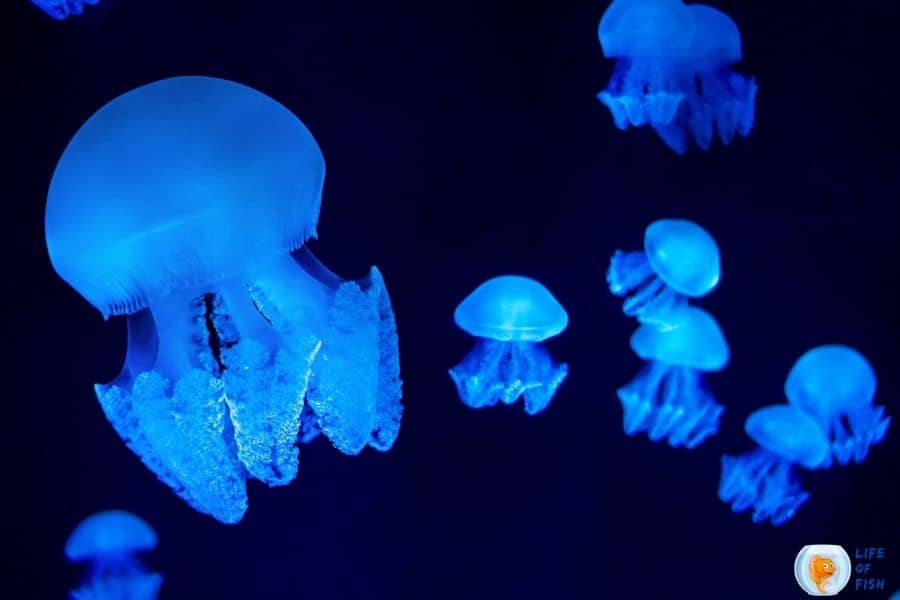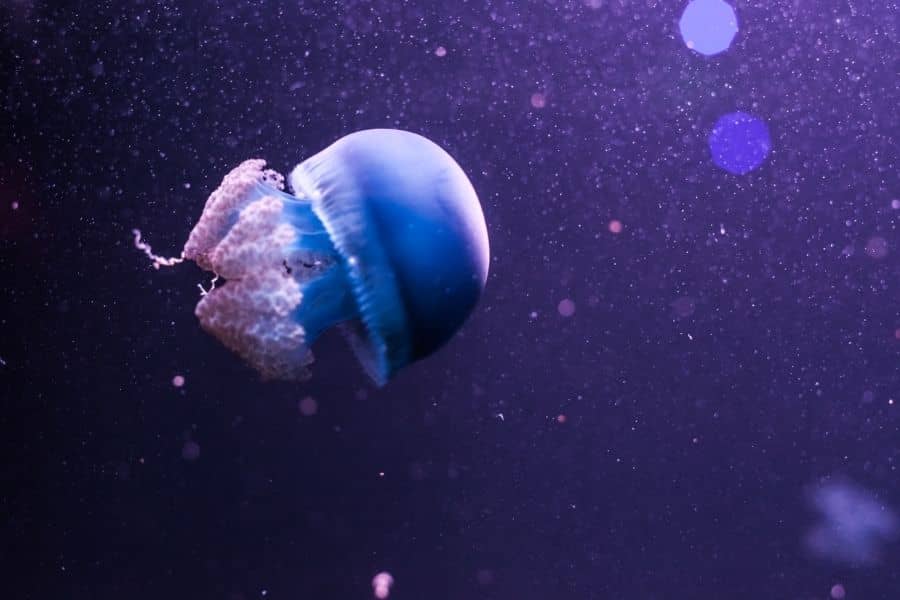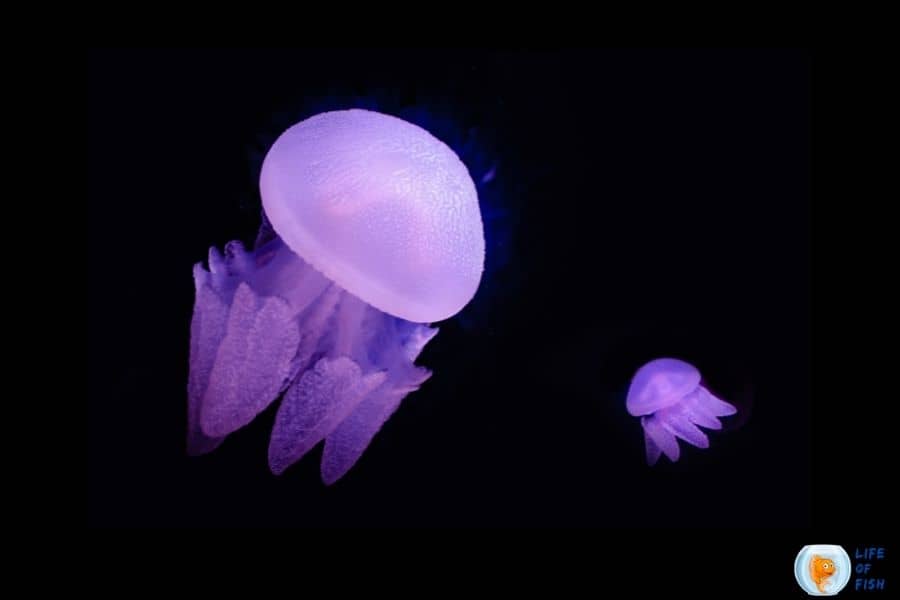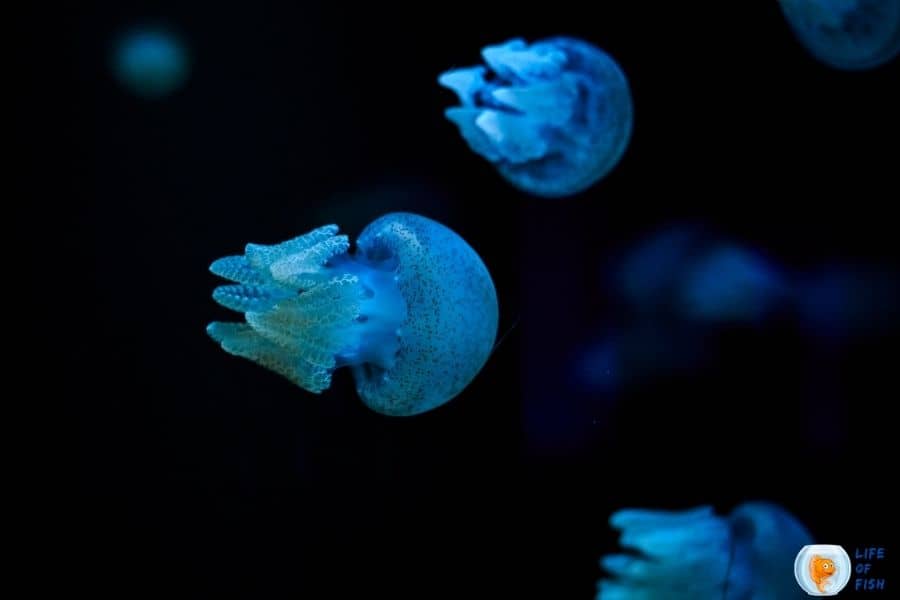Blue blubber jellyfish are cute-looking, somewhat cauliflower shapes creatures often found in Australia. Also known as blubber jelly, these Jellyfish are considered one of the least dangerous jellyfish species.
In China and Japan, these creatures are regarded as delicacies and are commercially harvested throughout the Indo-Pacific.
In addition, Blue Blubber Jellyfish are popular in the aquarium trade because of their rhythmic movement and bright colors.

Can you keep blue blubber jellyfish species as pets?
Jump To
- 1 Can you keep blue blubber jellyfish species as pets?
- 2 Blue Blubber Jellyfish Price
- 3 Get to know them
- 4 Blue blubber jellyfish care in aquariums
- 5 Water quality condition
- 6 The health of the blue blubber jellyfish
- 7 What fish can live with blue blubber jellyfish in aquariums?
- 8 Blue blubber jellyfish predators
- 9 Blue Blubber Jellyfish Breeding
- 10 Related questions
Yes. Blue blubber jellyfish or jelly blubber is one of the most popular jellyfish among aquarists worldwide.
They are colorful, active, and have an exotic look. Most importantly, these jellyfish sting is not deadly to humans. So, people tend to keep them in aquariums.
Blue Blubber Jellyfish Price
Blue Blubber Jellyfishes cost around $60 in the aquarium trade.
Get to know them
Originate in
Some jelly blubber species live in lagoons off the Australian eastern coast. They are often found in large blooms in Queensland, New South Wales, and Victoria.
Others live throughout the Indo-Pacific and Philippines islands.
Appearance and size
Although they are called blue blubber jellyfish, these Jellyfish come in various colors.
In addition to the most common color light blue to purple, these Jellyfish also comes in Brown, Burgundy, White and Purple colors.
Creamy white and brown color jellyfish are often found in Sydney waters, while blue Jellyfish are found in northern Australia.
The reason for this color variation is a pigment produced by the Jellyfish.
These Jellyfish usually grow for about 2.5cm but can be as large as 8.5cms in captivity. In the wild, they reach about 30-45 cm wide.
Their shape is distinctive, with a dome-shaped bell and somewhat cauliflower-shaped eight arms.
Unlike many other jellyfish species, jelly blubber is strong, active swimmers because their eight arms offer excellent rhythmic propulsion.

How long do blue blubber jellyfish live?
They have a short lifespan. The average lifespan of these species is about 12 months in captivity.
Growth rate
Jelly blubber grows until they die. Since these are small jellyfish species, you may not find any significant difference in jellyfish growing.
However, you can expect them to grow about ½ inch every month or two.
Food preference
Blue blubber jellyfishes capture tiny crustaceans and plankton, small fish, and small particles in the wild.
In captivity, you can feed them with baby brine shrimp, frozen baby brine shrimp, Ocean Nutrition Instant Baby Brine, or frozen copepods.
The behavior of blue blubber jellyfish
They are strong and active swimmers. Therefore, they prefer medium to high water currents in their surroundings.
You will find them swimming all over the tank all the time, searching for food. They are friendly towards other species.
Therefore, you can house these Jellyfish with other jellyfish species, such as red cross bubbler jellyfish.
Further, in the wild environments, large swarms of jellyfish or blooms washed into coastal waters due to ocean current, nutrients, temperature and many other reasons.
Are they toxic?
Like any other jellyfish, blue blubber jellies also have toxic stings. However, these stings are less dangerous to humans.
Usually, the stings result in mild effects such as slight redness around the area. However, some people are allergic to these stings and will experience itchiness for some time.

Blue blubber jellyfish care in aquariums
Like any other pet jellyfish, jelly blubber also needs specific tanks, water conditions, and food.
Blue blubber jellyfish tanks
Preferable size
Although jelly blubber grows small in aquariums, they are very active jellyfish, unlike other jellyfish types.
Therefore, they need plenty of space to explore. We recommend at least a 10-gallon aquarium for these creatures.
Substrate
Since these are free-swimming species, they do not require specific substrates in their surroundings.
You can use a substrate you prefer, but as per our experience, gravel works best because it is easier to clean gravel than other substrate types.
Do they need filters and air pump?
Unlike other jellyfish types, these species need a medium to high water current to prevent them from hitting the tank’s sides.
Therefore, we recommend including an air pump along with filters. We usually add a sponge or gauze filter, a biological filter (Nitrifying bacteria), and chemical filtration(active carbon bags) for a jellyfish tank.
Jellyfish are susceptible species, so they need clean water to thrive. Even a small amount of impurities can harm them. Therefore, filtration is necessary for pet jellyfish tanks.
Lighting
Jelly blubber does best in lighted aquariums. Since these are translucent creatures, lights make them stunning.
You can use various colored led lights for your aquarium.

Best aquariums for blue blubber jellyfish (commercial aquariums)
Jellyfish have special requirements when choosing a tank. They can not survive in square-shaped tanks. If left, they may get trapped in the corners.
Therefore, we keep Jellyfish in specially designed aquariums. These aquariums often are cylinder-shaped with minimum corners.
Although these aquariums are expensive, their elegant look and unique features make them worth every penny. Here are some stunning aquariums available in the market.
- Orbit 20 Desktop Jellyfish Aquarium
- Jellyfish Art Jelly Cylinder Nano
- Neo 4 & 16
- Medusa Desktop
- Omni 9 & 15
Where to place the tank
You can place your jellyfish tank anywhere you want, but a corner in the room is recommended for any aquarium for the sake of safety.
How many blue blubber jellyfish should be kept together per gallon?
We advise keeping one inch of bell diameter per gallon. Thus, for example, if you have ten gallons, you can add five 2-inch diameter jellyfish.
Water quality condition
Water (how to treat water, do not use tap water, use filtered water)
Blue Bubbler Jellyfish require saltwater to thrive in an aquarium.
Since jellyfish are highly sensitive species, you should not use tap water, spring water, purified water, mineral water, or alkaline water.
You should use RO/DI filtered water for jellyfish aquarium with added essential minerals.
Temperature
The preferred water temperature for them are about 24-28°C.
Salinity (do not use salt crystals to increase salinity)
They are saltwater species. Therefore they need about 1.023 SG salinity in the water.
But, according to some records, blue blubber jellies are also found in estuarine waters (brackish waters). So, it means that they can tolerate a varied range of salinities.
Hardness
The preferred water hardness is 7.4 – 8.4 DkH.
Ammonia, nitrate nitrate
The water should be Ammonia free (o ppm) but, Jellyfish can survive in small concentrations of Nitrite, Nitrate, and Phosphate.
The preferred water conditions are as below.
- NO2 < 0.05 ppm
- NO3 < 10.0 ppm
- PO4 < 2.0 ppm
PH
Since these are saltwater species, the pH level of seawater is required. they need about 8.1 – 8.4 pH levels in the water.
Water changing
You should perform 10 to 25% water changes bi-weekly to keep the aquarium detritus free.
Additionally, you should remove any uneaten food with a net daily to prevent food from rotting as blue blubber jellyfish can not tolerate polluted water.
If they live in dirty water for a prolonged period, they will eventually die.
Special tips
Test the quality of the water using a saltwater test kit before adding your Jellyfish into the tank.
To ensure a healthy environment in the tank, properly “cycle” the tank before adding any Jellyfish.

The health of the blue blubber jellyfish
Hence these Jellyfish have a short lifespan in aquariums; diseases are not yet explicitly recorded.
Despite that, they are known to be easy species to take care of in aquariums as they thrive when given ideal water conditions and plenty of food.
Different ways they can get hurt
Like any other Jellyfish , they are prone to accidents. If you keep this species in a tank with corners, they may get stuck between the corners and hurt.
And also, if you keep them in an aquarium with low to no water flow, they may hit the tank’s sides while swimming, causing unnecessary damages.
As we said before, unlike many other jellyfish , blue blubber jellyfish are strong, active swimmers because their eight arms offer excellent rhythmic propulsion.
So, they need a medium to high water flow inside aquariums to prevent mishaps.
What fish can live with blue blubber jellyfish in aquariums?
Blue blubber jellyfish are friendly towards other species. So, they can live in close proximity with other jellyfish. Some recommended tank mates are,
- Red Cross Blubber Jellyfish
- Other blue Bubblers
- Lagoons
- Upside Down Jellifish and
- Fried Egg Jellies
Blue blubber jellyfish predators
There is a massive decline in Jellyfish predators, causing jellyfish blooms in the sea. Some Jellyfish predators are Jelly-eating fish such as tuna, sunfish, butterfish, and spiny dogfish.
Sea turtle species also consume Jellyfish. For example, leatherback sea turtle totally depends on Jellies for food and can consume lots of jellies per meal.
Blue Blubber Jellyfish Breeding
Blue blubber jellyfish breed through both sexual and asexual reproduction. During the medusa stage, these Jellyfish produce eggs and fertilize them with male sperm.
These fertilized eggs produce larva called planula, which later becomes polyps. During the polyps stage, these Jellyfish reproduce through asexual reproduction.
In asexual reproduction, the polyp buds off to several clones of itself and develop into medusas.
Although the reproduction seems easy in blue blubber jellyfish, it actually is not in captivity.
There are records of successful culturing of these Jellyfish in captivity, but not in vast numbers.
However, in the wild, blue blubber jellyfish reproduce at an alarming rate, causing blue blubber jellyfish blooms.
Most blue blubber jellyfish that are sold at pet shops are often wild-caught ones. Hence they may bring some diseases and parasites with them.
So, if you plan to increase the number of Jellyfish in your aquarium, it is better to quarantine newly bought Jellyfish for about two weeks.

Related questions
Are blue blubber jellyfish easy to care for?
Unlike much other pet jellyfish, blue blubber jellyfish are easy to care for if given ideal water conditions and food.
Blue blubber jellyfish do well when fed with live baby brine shrimp. Many aquarists had success when fed small portions multiple times per day.
Even if you are a novice aquarist, you can easily keep blue blubber jellyfish at home if you follow these guidelines.
Can you touch a blue blubber jellyfish?
Blue blubbers also have stings in their tentacles. However, they are not poisonous to humans.
So, technically you can touch a blue blubber jellyfish. But, be prepared to have re swellings in the areas where tentacles were contacted and for minor irritation if you are prone to allergies.
Are blue blubber jellyfish edible?
Yes. Blue Blubber jellyfish are considered delicacies in China and Japan. They use these Jellyfish in sushi and sashimi.
They also dry and powder these Jellyfish to use in stews. Blue blubber jellyfish have 90% water and very little fat.
Rubber band salad made with Blue blubber jellies is a meal popular in China because of the texture, which is described as crispy yet stretchy.
Are Blue Blubber Jellyfish rare?
Not at all. Due to the recent decline in natural predators, blue blubber jellyfish populations are growing at an alarming rate.
However, these Jellyfish are commercially harvested throughout the Indo-Pacific, which controls the population to some extent.
Read Next: Can Octopus Breathe Air? | This Is What You Need To Know |
